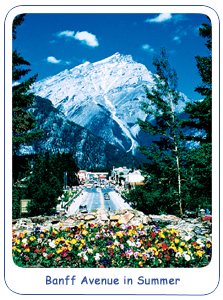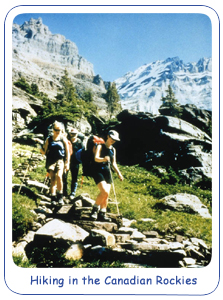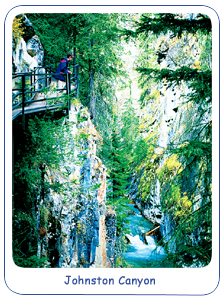

















Banff has been welcoming international visitors for more than a century. In 1883, the discovery of natural hot springs bubbling from the base of Sulphur Mountain led to the establishment of Canada's first national park. The United Nations further designated this area a "World Heritage Site" in 1985.
Today, Banff National Park offers 6,641 square kilometers (2,564 square miles) of spectacular Canadian Rocky Mountain landscape. For visitors, bathing in the hot springs is but one of many activities offered in Canada's foremost National Park. When you visit the Banff/Lake Louise area, you will see why more than 4.5 million visitors come each year to experience the glory of the Canadian Rockies. Bring your camera, and enjoy!
See the travel information page for information on how to get to Banff, as well as the passport/visa requirements to enter Canada.
The Banff area is spectacular for hiking in the summer. There are hundreds of hiking trails, ranging from the beginner to the extreme (e.g., scrambling, rock-climbing). Check out any hiking guide book for the Canadian Rockies. Popular outings include Fenland Trail, Bow Falls Trail, Grassi Lakes Trail, Tunnel Mountain Lookout, Sulphur Mountain Gondola, Johnston Canyon, Moraine Lake, Lake Louise, Athabasca Glacier, and a soothing soak in the Upper Hot Springs. Some of these are within walking distance from the hotel, while others will need a rental car for the outing.


For more information on recreational activities and not-to-be-missed opportunities in the Banff and Lake Louise area, see the Banff / Lake Louise Tourism Bureau.
Dubbed "Canada's highest town" at 1384 meters (4540 ft) above sea level, and nestled in world-famous Banff National Park, the town of Banff is home to 7500 year-round residents and over 1 million visitors annually.
When coming to Banff for WWW2007, please keep in mind Banff's higher elevation. Be prepared for a variety of weather conditions, including a drier climate and cooler days than those to which you are accustomed. Evenings can be especially chilly!
The average temperatures for early May are between 5C (41F) and 13C (55F). Occasional rain showers and even light snowfall may happen. While most mountain tops have snow year-round, the town of Banff itself does not. Nonetheless, you should always be prepared for a surprise change in the weather! Therefore, you may want to bring a sweater, warm jacket, gloves, umbrella, and warm footwear, along with your usual, casual spring attire.
If you are planning on long walks or hiking during your stay, also bring appropriate footwear: sturdy hiking boots for serious hikes or a good pair of running shoes for walking around town. Banff is located in the heart of the Rocky Mountain Range and as a result many hiking trails in the area are rocky and uneven. It is also important to keep in mind that for every 200 metres of elevation gained, the temperate will drop about 1C.
Much of Banff National Park is untouched by humans, and as a result even Banff itself is home to many different types of wildlife. It is not unusual to see deer, elk, bighorn sheep, and caribou wandering around. Moose and mountain goats are slightly more elusive, and although rare, bears and cougars too have been seen in the townsite. For bird lovers, many different types of birds can be seen in the Banff area including Canada geese, bald eagles, and grouse.
It is important to remember to keep a respectful distance from the wildlife, especially if they (or you!) are with their young. Even more important than that, please don't feed them, no matter how cute they are! Animal-proof trash receptacles are located throughout the townsite, and it is essential that all litter finds its way into these to keep the town clean and the wildlife healthy!
